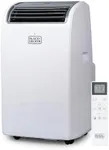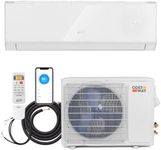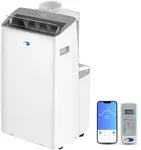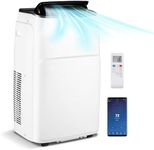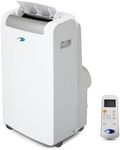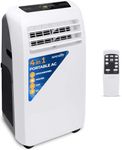Buying Guide for the Best Portable Air Conditioner Heater Combo
Choosing a portable air conditioner and heater combo can make your living space comfortable all year round, offering both cooling in the summer and warmth in the winter. When shopping for one, it's important to understand the main features and specifications so you can select a unit that matches your room size, climate, and personal preferences. By focusing on the right specs, you can ensure efficient performance, easy operation, and long-term satisfaction with your purchase.BTU Rating (Cooling and Heating Capacity)BTU stands for British Thermal Unit and measures how much heat an air conditioner or heater can remove or add to a room per hour. A higher BTU means the unit can handle larger spaces, while a lower BTU is suitable for smaller rooms. Typically, small rooms (up to 200 sq ft) need around 8,000-10,000 BTU, medium rooms (200-400 sq ft) need 10,000-14,000 BTU, and larger spaces may require even more. To pick the right BTU, consider the size of the room you want to use the unit in, as using a unit that's too powerful or too weak can lead to inefficiency and discomfort.
Energy Efficiency Ratio (EER)The Energy Efficiency Ratio (EER) tells you how efficiently the unit uses electricity to cool or heat a space. A higher EER means the unit uses less energy for the same amount of cooling or heating, which can save you money on electricity bills. EER values usually range from about 8 to 12 or higher. If you plan to use the unit frequently or for long periods, look for a higher EER to maximize efficiency and reduce running costs.
Room Size CompatibilityRoom size compatibility refers to the maximum area the unit can effectively cool or heat. Manufacturers often list the recommended room size in square feet. It's important to match the unit's capacity to your room size; a unit that's too small won't keep you comfortable, while one that's too large may cycle on and off too often, wasting energy. Measure your room and check the product's recommended coverage to ensure a good fit.
Portability FeaturesPortability features include wheels, handles, and overall weight, which affect how easy it is to move the unit from room to room. If you plan to use the unit in different areas of your home, look for lightweight models with sturdy wheels and convenient handles. If the unit will stay in one place, portability may be less important.
Noise LevelNoise level is measured in decibels (dB) and indicates how loud the unit will be during operation. Lower dB values mean quieter performance, which is important if you plan to use the unit in a bedroom, office, or other quiet space. Units typically range from about 50 dB (quiet conversation) to 65 dB (normal conversation). Consider your sensitivity to noise and where you'll use the unit when deciding how important this feature is for you.
Dehumidification FunctionMany portable air conditioner and heater combos also offer a dehumidification mode, which removes excess moisture from the air. This is especially useful in humid climates or during rainy seasons. The dehumidification capacity is usually measured in pints per day. If you live in a humid area or want to improve comfort by reducing stickiness, look for a unit with a strong dehumidification feature.
Control Options and ProgrammabilityControl options include remote controls, digital displays, and programmable timers. These features make it easier to adjust settings, set schedules, and maintain comfort without manual effort. If you value convenience or want to automate your comfort, look for units with user-friendly controls and programmable features.
Exhaust and Venting RequirementsPortable air conditioners and heater combos need to vent hot air outside, usually through a window. Check the type of exhaust hose and window kit included, and make sure it fits your window style. If you have unusual windows or plan to move the unit often, look for flexible venting options and easy installation.
Maintenance and Filter TypeRegular maintenance, such as cleaning or replacing filters, keeps the unit running efficiently and improves air quality. Some units have washable filters, while others require replacements. If you want low-maintenance operation, look for units with easy-access, washable filters and clear maintenance instructions.
